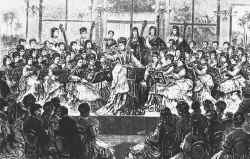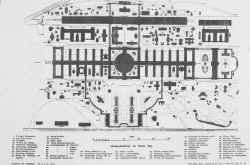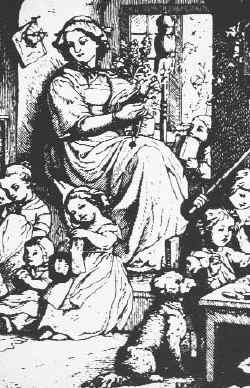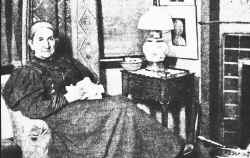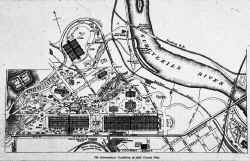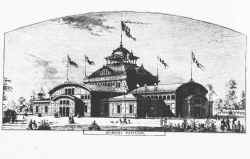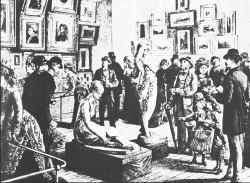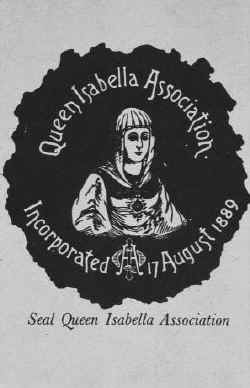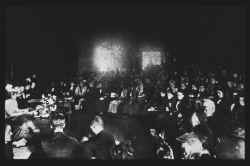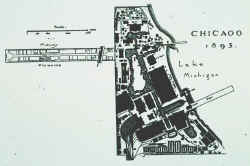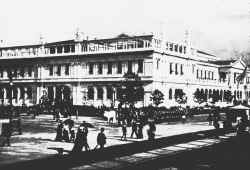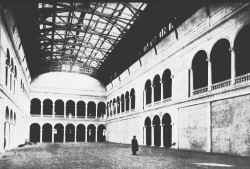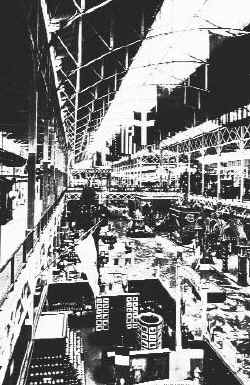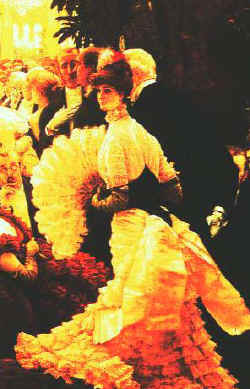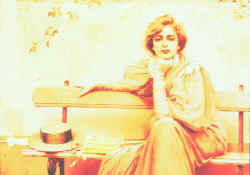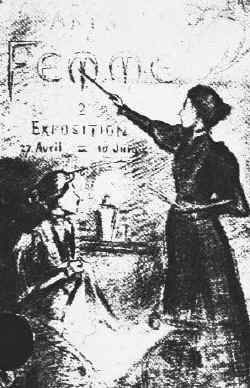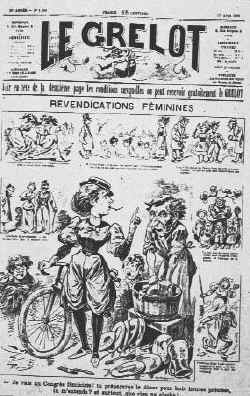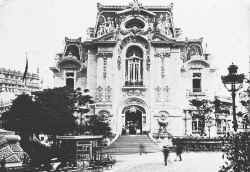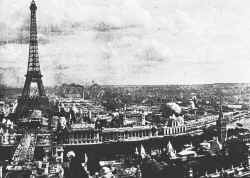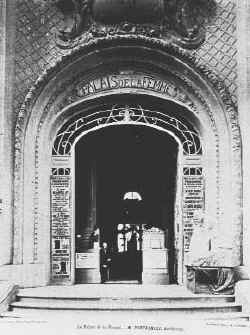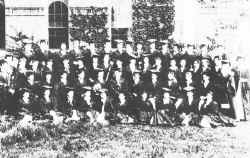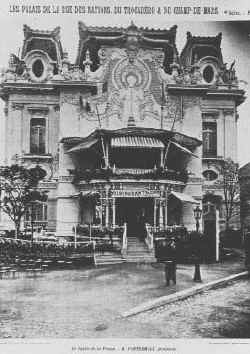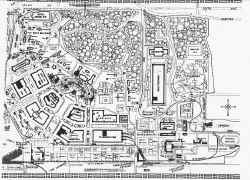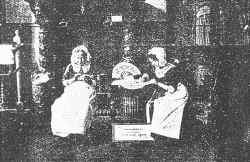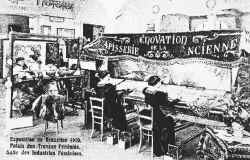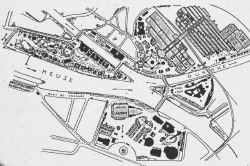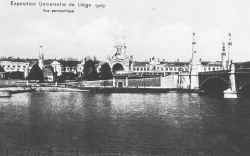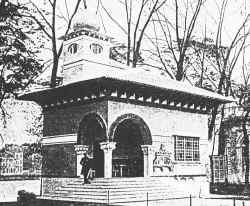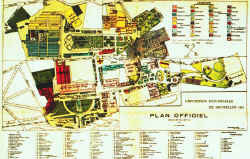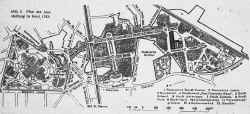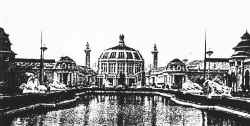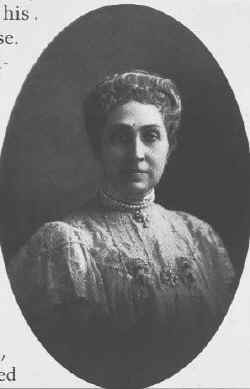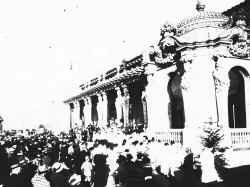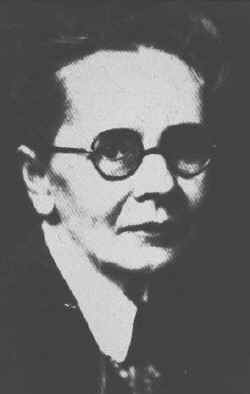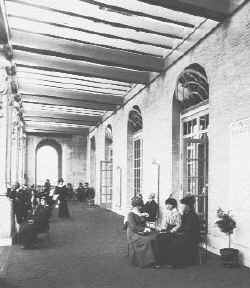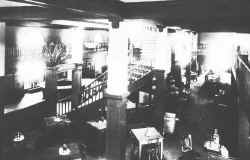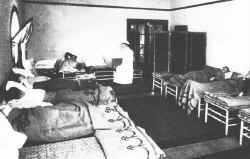
2000_1
Mary Pepchinski
The Woman’s Building and the World
Exhibitions:
Exhibition Architecture and Conflicting Feminine Ideals at
European and American World Exhibitions, 1873 – 1915.
During the last quarter of the nineteenth century and concurrent to the
emergence of women's movements in the United States and Europe, a new
type, the Woman's Building made it s appearance at the World Exhibitions.
Up until the First World War, it remained a significant component of these
events. Sixty percent of the World Exhibitions occurring between 1873
and 1915 contained a Woman's Building (1).
The appearance of Woman's Buildings at the World Exhibitions during this
period is somewhat perplexing, as prior to the First World War, the World
Exhibitions provided a showplace to present and to celebrate the industrial
production of the emerging nation states. Indeed, why was it necessary
to define gender difference at venues which championed the display of
industrial production?
To answer this question, I plan to investigate the notion that Woman's Buildings were constructed due to the intersection of two somewhat conflicting trajectories. Certainly, as Karen Offen has noted, associating specific economic activities or functions with bourgeois femininity was central to issues concerning political and economic power relevant to the growth of the nation states during the second half of the nineteenth century (2). Therefore, the construction of an exhibition building to represent bourgeois femininity clearly had a didactic function, as it located gender difference in relation to an emerging economic system. As we shall see, these Woman's Buildings and their vast displays and did not challenge prevailing feminine ideals, but repeatedly reinforced traditional female roles.
Meanwhile, between 1851 and continuing up to the First World War, the
World Exhibitions became the locus of "every kind of human activity"
(3), where any number of contemporary social or cultural concerns, such
as the emerging women's movements, found expression as well.
In the United States and Western Europe, the emerging women's movements
proposed to define the feminine ideal anew. Although the American and
European Women's movements varied in their goals, both demanded that women
occupy a more active role in the public sphere (4). The very presence
of Woman's Buildings at the World Exhibitions rendered this demand visible.
In this essay I plan to explore the thesis, that these two conflicting
trajectories, one given impetus by economic concerns and one which provided
a challenged a traditional construction of bourgeois femininity gave rise
to the Women's Buildings which appeared at the World Exhibitions 1873
and 1915. The Woman's Building: a "didactic" Typology?
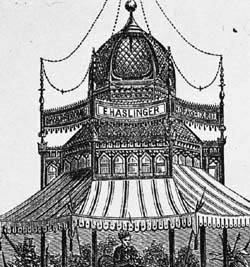
Slide 1: Flower Pavilion of the Viennese Florist Emilie Hasinger, Vienna World Exhibition, 1873. (Source: Gunda Barth-Scalmani and Margret Friedrich: "Frauen auf der Wiener Weltausstellung von 1873." in Brigitte Mazohl-Wallnig (Editors): Bürgerliche Frauenkultur im 19. Jahrhundert. Vienna, 1995.)
Slide 2: Ladie Orchestra, Vienna World Exhibition, 1873. (Source: Illustrirte Zeitung. Leipzig. October 1873.)
When considering the typology Woman's Building, several factors are important to consider. Products manufactured by women and activities meant to engage a female audience were displayed throughout the pavilion and spaces found at the World Exhibitions. The function of a Woman's Building was didactic: it was erected to describe and to affirm a bourgeois feminine ideal.
The participation of women at the American and at the European World Exhibitions was shaped by differing circumstances. In Europe, the exhibits in the Woman's Buildings as well as women's participation at the World Exhibitions concerned identifying a feminine ideal in relation to the intertwining roles of production and consumption (5). The names of the European Woman's Buildings ----"Pavillon der Frauenarbeiten", "Palais des Travaux féminins"---- called attention to women with work, or more precisely, work executed by and understood as being appropriate for bourgeois women. In contrast, the American World Exhibitions engaged the collective economic potential of bourgeois women. They were valued as fund-raisers, support workers and (paying) visitors; their participation helped insure the success of a World Exhibition. Furthermore, American women saw their World Exhibitions as a venue to present gender specific activities not solely defined by economics or political activity, what has become known as Women's Culture (6). Broadly defined, Women's Culture encompasses female activities and relationships not primarily motivated by direct political engagement, such as labor performed in the domestic sphere or participation in organizations where women played a dominant role (7). The architecture of the Woman's Buildings reflected the differing qualities of bourgeois women's participation at a World Exhibition. The European type typically contained galleries furnished with tables and vitrines displaying women's handiwork, while the American type had more of a variety of spaces allowing for a broader range of activity. One last factor contributing to the development of the type was the rapidly changing construction of the bourgeois feminine ideal. During the period in question, "an historically changing concept of what a women should be" (8) was profoundly shifting. Bourgeois women increasingly engaged in remunerative work and political activity or chose independence and careers over marriage and procreation. This changing construction of femininity attracted a variety of negative reactions, from disparagement to criticism and even aggressive backlash. As we shall see, these responses to emancipation also gave impetus to the creation of Woman's Buildings.
Vienna World Exhibition, 1873
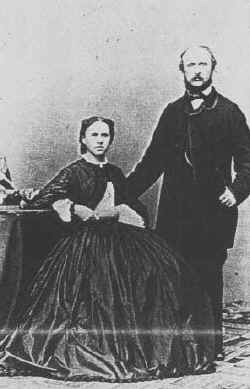
Slide 3: Rudolf and Jeanette von Eitelberger. (Source: Gottfried Fliedl: Kunst und Lehre am Beginn der Moderne. Die Wiener Kunstgewerbeschule, 1867 ? 1918. Salzburg/Vienna, 1985.)
Slide 4: Vienna World Exhibition 1873. Site Plan. (Source: Handbuch der Architektur. Ausstellungsbauten. Stuttgart, 1906.)
The first Woman's Building to appear at a World Exhibition, the Pavillon der Frauenarbeiten (Pavilion of Women's Work), was erected at the Vienna World Exhibition 1873. The office of Carl Hassenauer, supervising architect of the exhibition, was responsible for the design.
The Pavillon der Frauenarbeiten was constructed when the bourgeois feminine ideal,
where women were expected to seek satisfaction in domesticity and motherhood, was being
broadly challenged. Throughout Europe, the need for middle class women to train for
gainful employment was becoming evident. In response, organizations such as the Wiener
Frauenerwerbsverein (Vienna Women's Business Association), founded in 1866, and
administered by bourgeois and aristocratic women, undertook a variety of activities to
support women who remunerative labor (9).
Meanwhile, it was not simply the gainful employment of the middle class women which posed
a challenge to the feminine ideal, but the specter of untamed, non-connubial sexuality:
Vienna boasted the largest number of illegitimate urban births in Europe (more children
were born out of wedlock than as legitimate births) and one of the largest foundling homes
on the continent (10).
The special exhibition of women's work was proposed by Rudolf von Eitelberger, a leading
proponent of the movement to revive the applied arts in Austria. The idea to erect the
Pavillon der Frauenarbeiten (Pavillon of Women's Work) may have been suggested by his wife
Jeanette, who was active in the progressive Wiener Frauenerwerbsverein, serving as
president from 1874 to 1897 (11).
Rudolf von Eitelberger, founder of the Museum of Art and Industry in Vienna, had
closely modeled his activities to improve applied art production on contemporary English
precedents. Although women played an important role in the English Arts and Crafts
movement, they were expected to limit their activities to producing decorative arts and
needlework and to consuming handsome goods for the home. Under von Eitelberger's
direction, similar attitudes concerning of the participation of women in the Viennese
movement to revive the applied arts were current at the time of the World Exhibition. For
example, women were allowed to study at the School of the Museum of Art and Industry, but
were expected to limit their activity to needlework, flower painting and decorating
porcelain (12). Furthermore, von Eitelberger did not limit his activities to his own
institutions, but often contributed educational materials intended to improve bourgeois
women's taste and appreciation of the applied arts to the Weiner Frauenerwerbsverein (13).
Clearly, the creation of this pavilion provided von Eitelberger with another vehicle to
define gender roles --- men were invested with the responsibility of production and
distribution of well designed products and women were expected to consume with
discrimination and arrange objects tastefully in the home --- in relation to the revival
of applied art production (14).
Slide 5: Ernst Ludwig Richter. Die Hausfrau, woodcut. (Source: Gunda Barth-Scalmani and Margret Friedrich: "Frauen auf der Wiener Weltausstellung von 1873." in Brigitte Mazohl-Wallnig, Editors: Bürgerliche Frauenkultur im 19. Jahrhundert. Vienna, 1995.)
Slide 6: Vienna World Exhibition. Site Plan. The Pavilion der Frauenarbeiten is located among the small structures to the north of the Main Building. (Source: Ueber Land und Meer. Allgemeine Illustrirte Zeitung. Nr. 50. Leipzig, 1873.)
The first Woman's Building erected at a World Exhibition came into being due to an apparently simple reason: the exhibition of women's work was proposed fairly late in the planning of the event, sufficient space was no longer available in the Main Building. The Pavillon der Frauenarbeiten was a simple, wood frame building, located to the north-east of the Main Building, adjacent to other structures representing departments of the Austrian government. The women's exhibition shared space with second group, "the History of Invention". Plans of this structure have not been kept (15).
Although a number of women who were active in the administration of the Wiener Frauenerwerbsverein did participate in the selection and organization of the Pavillon der Frauenarbeiten, the project was directed by Jakob von Falke, an expert on the applied arts and assistant to Rudolf von Eitelberger at the Vienna Museum for Art and Industry. Initially, the Pavillon der Frauenarbeiten was to display a broad range of objects (including fine arts and literary production) executed by local and foreign women. In its final form, the presentation largely consisted of "feminine handiwork" ?small items, such as needlework, textiles, leather and pearl work ----executed by women from all corners of the Austro-Hungarian Empire. As "feminine handiwork" was not considered to be a high art form and was often executed without remuneration, the exhibition reinforced a bourgeois feminine ideal which championed domesticity, marriage and motherhood over gainful employment for bourgeois women. (16).To lend this construction of femininty further emphasis, a copy of a painting from Ernst Ludwig Richter, "Die Hausfrau", depicting a young mother fondly viewing a group of young children at play, was placed at the entry to the exhibit (17).
The small exhibition received extensive publicity and generated broad commentary. Many critics questioned why women continued to execute needlework when much of it was not only of poor quality, but was being rendered obsolete by the machine. Some, such as Jakob von Falke, drew the conclusion that bourgeois women should continue to execute needlework as a means to improve their taste, which would enable them to become more informed consumers of decorative items and accessories for the home (18).
Clearly, there were women who were uncomfortable with pavilion and its contents. Marianne Hainisch, observed that many women had not only objected to the Pavillon der Frauenarbeiten's premise, but that authentic "women's work" --- unpaid toil performed daily in the domestic sphere--- was impossible to present in a critical and meaningful manner in such a structure (19).
Philadelphia Centennial Exhibition, 1876
Slide 7: Elizabeth Duane Gillespie. (Source: Jeanne Madeline Weimann: The Fair Women. Chicago, 1981.)
Slide 8: Site Plan, Philadelphia Centennial 1876. (Source: Handbuch der Architektur. Ausstellungsbauten. Stuttgart, 1906.)
Although numerous American journalists reported on the Vienna World Exhibition for American newspapers and magazines (20), the modest Pavilion der Frauenarbeiten did not directly serve as precedent for the Woman's Building erected at the 1876 Centennial Exhibition in Philadelphia. The Philadelphia building was more prominent, its exhibits were more varied and women played a more engaged role in its organization than had been the case at the Vienna World Exhibition. Indeed, the Philadelphia Woman's Building occupied a significant position in the larger narrative of the Centennial Exposition as well as in teh developement of the type (21).
Why did this difference occur? In contrast to the hierarchical social structure and diversity (religion, nationality) which marked Europe of this period, American society being Protestant and non-urban, was more homogenous. This otherwise harmonious picture, however, was slowly being disrupted by growing economic uncertainty and combined with increasing transience among the population (22).
Meanwhile, bourgeois American women enjoyed greater access to the pubic sphere than their European sisters. During the Civil War of the 1860's, women from different classes throughout the Union had been thrust into public life by participation in the Sanitary Commission, an organization established to support the Northern Army. As Carroll Smith-Rosenberg has observed, "Drawn from their homes by male patriotic rhetoric, however, they did not return" (23). After the defeat of the South, northern American women continued their engagement in social and charitable work, particularly in urban areas. Their continuing engagement in the public sphere led women to call for parity with men in wages, education and employment opportunities (24).
Indeed, the Centennial Women's Building was a product of the new bourgeois American woman of the 1870's. Yet bourgeois women created the Women's Building in a profoundly different mode than what had appeared in Vienna, not only due to their increasing involvement in the public sphere, but as they collectively wielded real economic power in a way their European sisters did not. During the 19th century, American women were renown for their ability to raise funds for the benefit of charitable causes (25). To inspire national support for the 1876 Centennial Exposition, organizers asked a group of Philadelphia women to generate interest and secure voluntary contributions for the upcoming event. Under the leadership of Elizabeth Dune Glimpse, a Philadelphia resident and descent of Benjamin Franklin, the Women's Centennial Commission actively worked for the Centennial, but demanded that an exhibit of women's work be given a representative place at the upcoming exhibition (26).
In 1875, their request for "ample space" in the exhibition's Main Building
was rejected, due to over subscription by foreign nations. The idea to erect a separate
Woman's Building to house their exhibits was proposed by the Chairman of the Committee on
Grounds, Plans and Buildings for the Exposition, Thomas Cochran. He argued that while
introducing the factor of gender would disrupt the clarity of organization in the Main
Building, women would have more space and more autonomy in their own pavilion (27).
Centennial organizers granted them a building, but only it women were able to finance it.
The necessary $31,160 was raised in four months (28).
Slide 9: Exterior view, Women's Building, Philadelphia Centennial. (Source: Jeanne Madeline Weimann: The Fair Women. Chicago, 1981. p. 6.)
Slide 10: Interior view, Women's Building, Philadelphia Centennial. (Source: Jeanne Madeline Weimann: The Fair Women. Chicago, 1981. p. 5.)
The Woman's Building of the 1876 Philadelphia Centennial Exhibition was located to the north of the Machinery and Main Halls, in a park-like area surrounded by gardens and smaller pavilions. Designed by Hermann Schwartzmann, the supervising architect of the Centennial Exposition, female organizers later regretted the failure to commission a practicing architectural draftswoman, Emma Kimball, with the project. Although the profession of architecture was in its nascent state in the United States at the time of the Centennial, the omission is all the more striking as women did play a small but significant role as the designers of residential buildings at this time (29).
Nestled among a variety of structures ( pavilions for the federal states, foreign countries and commercial manufacturers) the Woman's Building was an innovative and imposing structure. A central tower rising to a height of 30 meters lent the structure a dominant appearance (30). Its plan, created from the superimposition of a square upon a Greek cross, was a novelty among the Centennial pavilions. Architectural writers noted that with the exception of four columns marking the crossing, the interior space was free of structural supports, which provided flexibility. Exhibits including fine and applied arts produced by American and foreign women were to be seen, along with a kindergarten, a library containing literature by women, and a printing office for a journal published during the Centennial by women. As was typical of the World Exhibitions for the time, women performed unusual lines of work -- such as a operating a steam engine --- in public (31).
Radical political activity cast a shadow upon women's participation at the exhibition. A "Declaration of the Rights of Women" was distributed b activists, led by Susan B. Anthony, at a meeting in Philadelphia's Independence Hall on July 4, 1776. Later in the day, the document was read in public at the nearby Independence Square (32). The Women's Centennial Commission, however, did not champion such sentiments and propaganda in support of suffrage was not exhibited in the Woman's Building (33).
As in Europe, the need for bourgeois women to be gainfully employed was becoming increasingly apparent in the United States (34). Mary Cordato has noted that although the Women's Centennial Executive Committee supported women's right to work, the vast displays inside the 1876 Women's Building tended to undermine this growing need (35). Cordato has noted that women's work presented as "a multifaceted phenomen that encompassed domestic, skilled or professional, and community related, voluntary achievements." Exhibits of non-remunerative labor, such as housekeeping and charity work, though, outweighed small displays of describing the activities of professional women (36).
European observers understood the building as a venue to exhibit "feminine
handiwork" and vehemently criticized the quality of the handiwork presented in the
building (37). Americans viewed the structure and its contents in a different light.
Although contemporary American
observers stressed the triviality of the objects displayed (38), mainstream women found
the building provided a legitimate, stimulating and popular place for them to meet and be
in contact with one another during the duration of the Centennial (39).
The World's Columbian Exposition, Chicago 1893
Slide 11: Seal, Queen Isabella Society. (Source: Jeanne Madeline Weimann: The Fair Women. Chicago, 1981.)
Slide 12: Isabella Pavilion. (Source: Jeanne Madeline Weimann: The Fair Women. Chicago, 1981.)
During the seventeen year lapse between Philadelphia and Chicago Woman's Buildings, women's representation at the World Exhibitions did not cease (40). Yet the Woman's Building erected for the 1893 Columbian Exposition revolutionized the type: it acquired a monumental form, celebrated the pariticipation of women in both the fine and applied arts, and engaged broad intrnational support.
The Columbian Exposition appeared during a period of rapid expansion, urbanization and industrialization which transformed the United States. According the historian Alan Trachtenberg, the "White City" produced "---an oasis of fantasy and fable at a time of crisis and impending violence---" (41).
Just as the homogeneity of American culture was eroding, the bourgeois feminine ideal was being challenged. Waves of immigration, particularly from Eastern and Southern Europe, were swelling the populations of the industrializing cities. At the turn of the century, three quarters of Chicago's population of one million were foreign born (42). Carroll Smith-Rosenberg has noted that with immigration to cities, shared values and experiences not longer existed between native and newly arrived women, and the solidarity and the dialog developed between bourgeois and working class women which had existed in previous decades begins to break down (43).
The racial composition of the United States was changing as well. Harsh, racist and restrictive Jim Crow laws enacted in the southern states during Reconstruction propelled southern blacks to move away from the Deep South, mainly to the west, first in for Kansas, and later in the Oklahoma Territory. A strong black middle class was emerging, and black middle class women, --- like their white counterparts ---- founded clubs with the goal of improving social services to the black community (44).
And bourgeois American women were redefining femininity as well. During the 1880's, a new feminine ideal emerged in the United States: the "New Woman" was single, educated in a university and financially independent (45). As Judy Sund has observed, it was a group of these "New Women", the Isabella Society, had intended to erect a pavilion at the 1893 Columbian Exposition, to honor Columbus' sponsor, Queen Isabella of Castile, and provide spaces for their organization (46).
Slide 13: Board of Lady Managers. (Source: Jeanne Madeline Weimann: The Fair Women. Chicago, 1981.)
Slide 14: World's Columbian Exposition, 1893. Site Plan. (Source: Werner Hegemann and Elbert Peets: The American Vitruvius: An Architect's Handbook of Civic Art. (1922) 1988. New York.)
Their bid was destroyed by Bertha Potter Palmer, a powerful
Chicago businesswoman, socialite and president of the Board of Lady Managers, a group
aligned with the organizers of the Exposition. They had lobbied to insure women's
contribution as producers of manufactured goods was properly documented and represented in
the exhibition's main halls, and that women were to be named to the official juries.
Initially, Palmer had intended to erect a "Woman's Building" to house a
historical exhibit of the progress women had achieved since Columbus' discovery of the
Americas and to provide office space for the Board of Lady Managers (47).
Sensing the Isabella's' undertaking might hamper the prestige of her own project, Palmer
defeated the Isabella's proposal. She argued that only one Women's Building, bringing
together women from national (and not local) organizations should represent all women at
the fair (48).
Slide 15: Woman's Building, Exterior. (Source: Unsere Weltausstellung. Chicago, 1893.)
Slide 16: Women's Building, Interior.(unfinished) (Source: Unsere Weltausstellung. Chicago, 1893.)
Under Palmer's direction, the Woman's Building and its vast contents produced a
selective portrayal of white, bourgeois femininity. The project reflected the biases of
women like Bertha Potter Palmer: generally supportive of women who sought a role for
themselves in the public sphere, but who rejected "...politics, suffrage, or other
irrelevant issues" as being appropriate feminine concerns (49).
This Woman's Building, one of the major exhibition comprising the neo-classical White
City, offered gender-specific microcosm of the prejudices that dominated the Chicago fair.
For example, black Americans were denied both a representative building at the Chicago
Exposition and female Black Americans were excluded from participation on the Board of
Lady Managers (50).
Slide 17: Agriculture Building, Interior. (Source: Unsere Weltausstellung. Chicago, 1893.)
Slide 18: Women's Building, Interior. (finished). (Source: Unsere Weltausstellung. Chicago, 1893.)
Palmer and her Board of Lady Managers produced a novel structure, different from preceding Woman's Buildings and from the other major structures forming the White City in that it was multi-functional structure in the broadest sense, containing galleries, a shop, offices, a restaurant, hotel rooms, and assembly spaces. This Woman's Building also attracted substantial participation from women outside of the host nation. Due to Palmer's extensive efforts, women from forty countries submitted national displays, contributed books to a library containing works by female authors or spoke at an accompanying Congress (51).
Palmer's other transformation of the Woman's Building reflected the growing association of bourgeois femininity with the patronage of the fine arts. During the second half of the nineteenth century, a "feminization of the arts" occurred in the United States, where bourgeois women became identified with the patronization, and to a lesser extent, the production of the fine arts. Particularly between 1870 and 1880 "the ladies of high society" became a central force working for the erection of monumental public fine museums to view the fine arts. Alan Trachtenberg has observed, "Open to the public, such institutions seemed to their advocates and supporters democratic enterprises, serving to diffuse knowledge , taste and refinement. What they in fact diffused, however, was a set of corollaries to the idea of culture. Organized by the urban elite, dominated by ladies of high society, staffed by professionally trained personnel, housing classic works of European art donated by wealthy private collectors, the museums subliminally associated art with wealth, and the power to donate and administer with social station and training. Their architecture reinforced the message: magnificent palaces with neoclassical fronts, marble columns, sweeping staircases, frescoed ceilings, and stained-glass windows. The splendor of the museums conveyed an idea of art as public magnificence, available in hushed corridors through a corresponding act of munificence by private wealth...." (52).
The interior of this Woman's Building did not resemble that of a typical exhibition pavilion, where exposed steel and wood structures provided a temporary enclosure for vast quantities of manufactured goods. Instead, the internal spaces of the Chicago Woman's Building were designed to convey the feeling of a "magnificent palace". Details such as the wood construction covered with plaster suggested the "marble columns", large, prominent murals recalled the "frescoed ceilings" of a new American art museum. Just as the interior of a fine arts museum was created to impart "knowledge, taste, refinement" on visitors, this Woman's Building was to evoke these qualities and associate them with a bourgeois feminine ideal.
Although the 1876 Philadelphia Woman's Building displayed the work of female artists, serious artists considered it a nothing more than a "bazaar". Aspiring and talented women were advised not to exhibit their art in it (53). Bertha Palmer's biggest contribution was to attempt to transform the Woman's Building into a structure which recalled the sobriety of an American museum of fine arts and provide a legitimate venue to view art and design.
In a sense, it was Bertha Palmer --- more than the young female architect, Sophia Hayden --- who designed this Woman's Building. During the initial planning phase in 1891, Palmer developed the dimensions of the plan (a rectangle measuring 200 feet by 400 feet) and the idea of the structure (a central skylit hall illuminating the interior) with the Fair's supervising architect, Daniel Burnham (54). She oversaw the competition among female architects where Hayden emerged as victor (55).Over Hayden's protests, Palmer appointed the renowned American designer, Candace Wheeler, to co-ordinate the building's interior decorations. She also supervised the choice of other decorators who designed smaller rooms in the structure. Indeed, Sophia Hayden's contribution consisted of designing the structure's carefully articulated massing and developing the facade, an eclectic mix of Renaissance and neo-Classical detailing (56).
Palmer strove to realize an esthetically pleasing, and not simply a functional, exhibition building. To this end, she commissioned collected and arranged art, design by female artists to be carefully placed in the Women's Building. Of note was the Central Hall ---erroneously labeled the Rotunda as the space was neither round in section nor in plan --- furnished with neo-classical ornamentation, which housed an exhibit of paintings, including a historical survey of women's art and works by leading American, German, French and English female artists (57).
As Kathleen McCarthy has shown, Palmer's vision proved uncomfortable, particularly for the women commissioned to execute the art and design, or invited to exhibit their work. Whereas Mary Cassatt's initial negative reaction to the Woman's Building has been well documented, less established artists were ambivalent as well. Sara Hallowell, a leading art broker, advised Palmer against the project. In her estimation, the problem was twofold: there were too few accomplished female painters and talented female artists preferred to exhibit in a mainstream, and not in a sex-segregated, venue. Indeed, Palmer's philanthropy from on high was viewed as damaging by the women she strove to support. The American painter Anna Lea Merritt observed: "Recent attempts to make separate exhibitions of women's work were in opposition to the views of the artists concerned, who knew that it would lower their standard and risk the place they already occupied. What we so strongly desire is a place in the large field,... the kind ladies who wish to distinguish us as women would unthinkingly work us harm." (58)
Exposition Universelle et Internationale de Paris, 1900
Slide 19: (The Parisienne). The Political Lady, J. Tissot 1883-85. (Source: Tamara Garb: Bodies of Modernity. London, 1998.)
Slide 20: (The Femme Nouvelle) Dreams, Vittorio Matteo Corcos. (Source: Geneviéve Fraisse and Michelle Perrot, eds.: A History of Women, Vol. 4. Cambridge and London, (1991) 1993. Cover photo.
Due to changes in French educational laws in the 1880's that gave women the right to higher education, a feminist movement emerged in France during the 1890's. Higher education had enabled a small --- but visible --- minority of career-oriented, educated and independent women to be labeled the "femme nouvelle". Two feminist congresses held in Paris in 1889, concurrent with the World Exhibition and devoted to women's rights and women's work, respectively, marked the beginning of more fervent, and sometimes conflicting, activities of the 1890's. Between 1892 and 1900 four further congresses devoted to feminist themes were held in Paris and twenty-one feminist periodicals were founded (59).
Fundamentally different from the feminism emerging in the United States, the French women's movement was largely subscribed to by bourgeois and aristocratic women, who accepted the notion of separate spheres, with marriage, maternity and domesticity being the appropriate vocation for women. Their goals were to foster solidarity among women of different classes through a variety of social welfare projects and to reform restrictive marriage laws (60).
During the last decades of the 19th century, a unique bourgeois feminine type, the "Parisienne", appeared. As Tamara Garb has observed, the fashionable, "Parisienne" was "...the ultimate counterpoint to the bourgeois male....". Extravagantly dressed, carefully coiffured she demonstrated "...the glamour and superficial excesses that money and modernity could buy." (61)
The "Parisienne" was a public figure, found strolling along the newly created boulevards and parks of the metropolis. As Garb has noted, she was essential to the functioning of the French economy, consuming cosmetics, clothing, toiletries at the department stores and arcades and supporting services such as the fashion magazines and hair styling salons created to enhance and inform her appearance. Paris was the beneficiary of her efforts, as the allure of a city populated by beautiful women strolling the newly created boulevards, was an unique urban attraction in and of itself. "The city", noted Garb, "constituted her stage." (62)
Slide 21: Catalogue, Exhibition of the Arts of Woman. 1896. (Source: Debora L. Silvermann: Art Nouveau in Fin-de-Siècle France. Berkeley, 1989.)
Slide 22: Suffragette, caricature (Source: Debora L. Silvermann: Art Nouveau in Fin-de Siècle France. Berkeley, 1989.)
Beginning in the middle of the 1890's, a concerted reaction to the "femme
nouvelle" arose. The independent "femme nouvelle" was perceived as a threat
to stability and order, in particular to the sanctity of the family, while her lack of
concern for her appearance challenged the city's identification with the
"Parisienne" and endangered industries and economies established to serve her
needs (63).
To counteract the "femme nouvelle's" perceived threat, a movement to renew the
decorative arts in France emerged during the 1890's. Bourgeois women, as consumers,
producers and most importantly as patrons of the arts, were understood as being crucial to
this campaign's success. Thus, the "Parisienne" was to expand her field of
consumption to include the decoration and enrichment of the home (64).
Slide 23: Palais de la Femme (Source: Collection Prof. Mary Pepchinski)
Slide 24: Birds eye view. Exposition Universelle, 1900. (Source: Collection Prof. Mary Pepchinski)
These conflicting bourgeois feminine ideals, present in
fin-de-siécle Paris, were accommodated at the Palais de la Femme, constructed for the
1900 Exposition Universelle et Internationale de Paris. The small pavillon was located
between the base of the Eiffel Tower and the Pont d'Iéna and surrounded by other small
exhibition buildings.
The Palais de la Femme's ground floor served the needs of the "Parisienne":
"Displays of objects for the toilette and articles for personal hygiene" (as
well as services such as chambermaid and a hairdresser) "repaired any damages,
disarray or destruction to clothing or hair style" (65). On the upper level, a room
for concerts, day care services for children, a reading room stocked with international
literature by female authors (66) and information concerning the women's movement,
provided attractions for the "femme nouvelle". And patriotic French women could
view nationally produced handwork and applied arts manufactured by women. displayed in the
upper level, or purchase it in a ground floor shop (67).
The Palais de la Femme was atypical of the European Woman's Buildings, being a multi-functional structure more closely resembling the American type. The unusual program reflected the experience of its organizer and initiator, a Madame M. Pégard. A leading bourgeois feminist and pivotal figure in the movement to renew applied art production through the participation of women, Pégard had directed the French section of the 1893 Chicago Women's Building. Her experience in Chicago, where she encountered the American woman's "independence, initiative and authority" (68) inspired much of her work in the women's and applied arts movements in France duirng the 1890's (69).
Slide 25: Entrance, Palais de la Femme (Source: (Source: Collection Prof. Mary Pepchinski) Slide 26: Side view, with Restaurants (Source: Collection Prof. Mary Pepchinski)
Not as well financed a previous structures, the Palais de
la Femme was criticized as spaces had been leased to private entrepreneurs, such as
restaurants and a hairdresser (70). This criticism aside, the structure was praised for
conveying a sense of the "Parisienne". According to one observer, the pavilion
was executed in a "charming Baroque style" (71).
Another suggested that the building's detailing recalled the artifice of the
"Parisienne": "....a small masterwork of modern French architecture,
decorated with tasteful latticework, flowers, artful stone basins and fountains, it
belongs to the most elegant and at the same time also the most inviting building of the
exhibition. The architect, M. Poutremoli, understood how to embody the grace and
attraction of appealing femininity in stucco and stone." (72).
Louisiana Purchase Exposition, St. Louis, 1904
Slide 27: Wellesley College Graduates. (Source: Geneviéve Fraisse and Michelle Perrot, Editors: A History of Women, Vol. 4. (1991) 1993.Cambridge and London.)
Slide 28: Women suffragettes (England). Source: Geneviéve Fraisse and Michelle Perrot, Editors: A History of Women, Vol. 4. (1991) 1993. Cambridge and London.)
By 1900, American women increasingly worked, studied at the university level, belonged to clubs or social and philanthropic organizations. Growing industrialization and the expansion of cities brought about professional opportunities for women and provided them with more leisure time (73). After 1900, a second and third generation of "New Women" appeared, more concerned with self-fulfillment and sexual experimentation than previous generations (74).
Slide 29: Site plan, St. Louis, 1904. (Source: Paul Sigal: Exponiert. Berlin, 2000)
Yet the changing bourgeois feminine ideal which emerged after 1900 does not completely explain why the Woman's Buildings lost their representative form at the American World Exhibitions. The answer, I believe, can be found in the legacy of the Columbian Exhibition. Commenting upon the impact of this World Exhibition, the historian Alan Trachtenberg has observed that the Neo-Classical architecture of the exhibition's White City, conveyed the impression of a unified homogenous American culture and confirmed the hegemony of an elite, ruling class. Populist sentiments and diversity were suppressed (75). Arguably, the bourgeoisie was no longer threatened in the way they had been prior 1900. The didactic expression of feminine ideal was no longer imperative.
The experience of women at the Louisiana Purchase Exposition in 1904 suggests that both conditions --- the growing emancipation of as well as the affirmation and acceptance of an elite American culture ---- contributed the type's obsolescence in the United States.
A Board of Lady Managers was appointed to the 1904 Louisiana Purchase Exhibition in St. Louis, for the simple reason that one had existed at the Chicago exhibition. Many of the women appointed to the St. Louis board were either extremely wealthy or had married influential and powerful men. Others had achieved recognition through their own efforts in business or the professions. Collectively, they had engaged in diverse undertakings in the public sphere prior to their engagement for the 1904 exhibition. This Board of Lady Managers was concerned less with the interests of women, more with the general success of the exhibition. Offered $50,000 by the fair organizers towards the erection of a Woman's Building, female organizers rejected the offer, preferring to have worked produced by women exhibited in the main exhibition halls. A second offer, to use an existing building on site for their offices and entertainment was accepted. Located outside the main exhibition area, it was used as a temporary office space and social events. It later served as the physics hall of Washington University (76).
The Belgian World Exhibitions: Lüttich/Liége 1905, Brüssels/Bruxelles1910, Gant/Ghent1913
Slide 31: Female Hand Lacemakers, Brussels, 1910. (Source: Daheim. 46 Jahr. Nr. 39. 25 July, 1910.)
Slide 32: Women operating Lace making machines, Brussels 1910. (Source: http:/users.skynet.befuncard/indusfem.jpg) Following Paris, three further Woman's Buildings appeared at the smaller Belgian World Exhibitions of 1905 (Liége/Lüttich), 1910 (Bruxelles/Brüssels) and 1913 (Gand/Ghent).
Slower than other European nations to developed a women's movement, Belgium only witnessed the significant feminist activity at the close of the nineteenth century. During the 1890's a small group of women briefly agitated, for suffrage. Bourgeois women did achieve some gains: they were permitted entry to universities in Brussels, and a national women's council was established in 1905. However, the impact of these progressive tendencies appears to have been slight, as leading Belgian feminists, such as the pioneering lawyer and women's rights activist Marie Popelin, found their work more appreciated abroad than at home (77).
At the beginning of the twentieth century, the Belgian women's movement increasingly
came under the influence of socialism. Feminist activists were most successful when
advocating for the protective laws for working women. In certain highly industrialized
areas, female textile workers joined women's organizations in large numbers. The women's
suffrage movement received support from socialist organizations, who saw in women voters a
potential "weapon" against the conservative political alliances dominated by the
Catholics and clergy (78).
As has been in evidence at the other World's Fairs, the Belgian Woman's Buildings did not
provide a platform for these emergent feminist sentiments.
Bertha Palmer's personal diplomacy on behalf of the Chicago Women's Building a decade
earlier, along with the erection of the Palais de la Femme at the Parisian World
Exhibition of 1900, contributed to the enthusiasm for the type in this nation. In 1892
Palmer had visited Belgium to inspire interest in the 1893 Chicago Woman's Building and
was warmly received. The Queen acted as patroness of the Belgian women's committee for the
Chicago Exhibition and at Palmer's suggestion, the Countess de Denterghem organized an
exhibition of women's work in 1892 (79).
The Belgian Woman's Buildings largely exhibited traditional handicrafts and
contemporary applied art production executed by women. As in previous Woman's Buildings,
such displays were not meant to call attention to middle class women's need for
remunerative labor, as bourgeois women who engaged in applied arts were expected to limit
themselves to the execution of "feminine handwork" or at best collaborate with a
spouse who was himself a professional in this field (80).
Occurring over the course of eight years in a small country, the planning of the three
structures was marked by similarities in organization and purpose. The Princess Albert of
Belgium acted as patroness, while the Countess John d'Oultremont and a Monsieur Paul
Wauters of the Belgian Ministry of Industry and Work served as the directors of the
buildings constructed in Liége and Brussels (81).
Exposition universelle et internationale de Liége, 1905
Slide 33: Exposition universelle et internationale de Liége, Site Plan.(Source: Architektonische Rundschau. 1906. Heft 2.)
Slide 34: Exposition universelle et internationale de Liége, Site Photo. (Source: Collection Prof. Mary Pepchinski)
The Exposition universelle et internationale de Liége was located at four riverbanks, facing the confluence of the rivers Ourthe and Meuse. The Palais de la Femme was situated at the Parc d'Acclimation, where according to contemporary architectural writers, the most interesting pavilions representing the Africa, Asian colonies, and the Balkans as well as a building to display the fine arts, had been erected (82).
Slide 35: Exposition universelle et internationale de Liége 1905, Pavilion, Montenegro; the Palais de la Femme can be seen at the right corner of the photograph .(Source: Architektonische Rundschau. 1906.Heft 2.)
Slide 36: Exposition universelle et internationale de Liége 1905, Pavilion, Bulgaria. the Palais de la Femme can be seen at the left corner of the photograph .(Source: Architektonische Rundschau. 1906. Heft 2.)
One contemporary report noted that ,"the Palais de la Femme, in a French style, consisting of two decorated pavilions connected by an open hall, contains a much admired collection of expensive Belgian lace and other artistic feminine handwork, from old and recent times .... .." (83).
Exposition universelle et internationale de Bruxelles, Brussels 1910
Slide 37: Exposition universelle et internationale de Bruxelles, Site Plan. (Source: Erik Mattie: World's Fairs. New York, 1998.)
Slide 38: Exposition universelle et internationale de Bruxelles, Palais des Travaux
féminins (Source: Collection Prof. Mary Pepchinski) Brussels, 1910 For the Universelle
Exhibition in Brussels 1910, the Palais des Travaux féminins, a neo-classical, single
story building, was situated adjacent to the pavillons of the Belgian section at southern
entrance to the fairgrounds. Of the three Belgian Woman's Buildings, the Brussels
pavilion, designed by the architect van Voorde, was the largest and contained the most
diverse exhibits. It was also enjoyed the most extensive international participation of
the three, as women from the Netherlands, Haiti, South America, Uruguay, Turkey and
Germany submitted objects for display (84).
Although the Belgian lace industry had been industrialized in the 19th century, female
lace makers, producing the product by hand and wearing historical costumes, provided a
notable attraction (85).
Exposition universelle et internationale de Gand/Wereldtentoonstelling Gent, 1913
Slide 39: Exposition universelle et internationale de Gand/Wereldtentoonstelling Gent (1913), Site Plan. (Source: Zentralblatt der Bauverwaltung. 2. August 1913.)
Slide 40: Exposition universelle et internationale de Gand/Wereldtentoonstelling Gent (1913) - Court of Honour. (Source: Zentralblatt der Bauverwaltung. 2. August 1913.)
For the Exposition universelle et internationale de Gand/Wereldtentoonstelling Gent (1913) a semi-detached pavilion, located at the southern entry to the exhibition, displaying applied arts production by women was connected to the main complex. The structure was also designed by the architect van Voorde (86).
Panama-Pacific International Exposition, San Francisco, 1915
Slide 41: Photo Phoebe Hearst. (Source: Sara Holmes Boutelle: Julia Morgan Architect. New York, 1988.)
Slide 42: Exterior, YWCA Building (Source: Sara Holmes Boutelle: Julia Morgan Architect. New York, 1988.)
As war raging in Europe, one last pavilion appeared at an American World Exhibition. At the insistence of the local heiress Phoebe Hearst, a building to provide refreshment to women visitors and workers at the Panama-Pacific Exhibition of 1915, held in San Francisco, was erected. The building, though, was financed and sponsored by the YWCA - Young Women's Christian Association -- an organization which provided services to young women seeking work in large industrializing cities during the early 20th century. A didactic representation of the bourgeois feminine ideal was no longer provided the impetus for the construction of this Woman's Building. Instead, the type's premise had shifted: the presence of women in the public sphere was now accepted and required accommodation (87).
Slide 43: Photo Julia Morgan (Source: Sara Holmes Boutelle: Julia Morgan Architect. New York, 1988.)
Slide 44: Detail, Porch, YWCA Building (Source: Sara Holmes Boutelle: Julia Morgan Architect. New York, 1988.)
The architect Edward C. Champney of San Francisco designed the YWCA Building's exterior. It was conceived of as a symmetrical pendent to a second structure, the Press Building, both of which framed the exhibition's main entry. Probably at the suggestion of Phoebe Hearst, the architect Julia Morgan was asked to design the pavilion's interior. Morgan was the first women to graduate from the Beaux-Arts in Paris and in 1904 had established a successful practice in San Francisco Bay Area. As opposed to Sophia Hayden, whose facade design for the 1893 Chicago Women's Building can been seen as a debut work, Morgan a seasoned professional, having built extensively for both the Hearst family as well as for the YWCA (88).
Slide 45: Ground Floor, YWCA Building (Source: Sara Holmes Boutelle: Julia Morgan Architect. New York, 1988.)
Slide 46: Upper-Level resting room (Source: Sara Holmes Boutelle: Julia Morgan Architect. New York.)
Although the two story structure contained a restaurant,
offices, club rooms, galleries, an assembly hall and resting rooms, it was less a venue to
support activities and exhibitions associated with Women's Culture, more a place to relax
and revive oneself after visiting (or working at) the fair. The successful restaurant
(open to both sexes) earned the YWCA a substantial profit (89).
In San Francisco, the final Woman's Building constructed at a World Exhibition prior the
end of the First World War no longer provided an emphatic representation of bourgeois
femininity. This was most profoundly reflected in the building's location: devoid of its
didactic premise, the type ceased to merit a representative site at the World Exhibition.
Function had overtaken meaning: this building was created to serve women working and
participating in the public sphere.
Conclusion
As we have seen, there would be differing economic imperatives to support the creation of a Women's Building at a World Exhibition. They affirmed women's position in the public sphere, while upholding a bourgeois feminine ideal that did not challenge or question relations of economic power or politics. Women were permitted to participate in the ephemeral public sphere the World Exhibitions presented, providing their presence did not disrupt the larger narrative of these events.
Beginning with the earliest Women's Building (the 1873 Pavillon der Frauenarbeiten) contemporary observers repeatedly noted that these buildings and their contents failed to provided a substantial critique of bourgeois femininity, or evoke the energy and invention which characterized the "New Woman". One visitor to the 1900 Parisian Pallais de la Femme expressed his disappointment noting, "...one only showed a modern woman in the sense of a fashion journal" (90). Similar views can found for many of the buildings mentioned.
Women's Buildings never provoked unease, or challenged the status quo, or stimulated women to rethink femininity in a radically new, expanded mode. Nor were these buildings were meant to be inclusive: femininity was presented as a selective, indeed an elitist quality. In the American Woman's Buildings, this can be seen in their exclusion of Afro-American and immigrant women from participation. In the European examples, native women of the colonies and working class women were at best marginally present as contributors to the buildings and their contents.
Although the World Exhibitions attempted a presentation of diverse human production and activities, the Woman's Buildings did not portray femininity in terms of difference and diversity, but affirmed traditonal feminine ideals during a period marked by extreme and radical change.
Footnotes:
- No comprehensive history of the Woman's Buildings at the
World Exhibitions, or of the Women's Buildings constructed at smaller venues, such as
local and national exhibitions, has been written. Various buildings have been discussed
individually; references to these will appear in the following text.
- Offen: (1992) p. 78. See also Barrett: (2000) pp. 45 - 52; and Scott: (1999). pp. 41
- 50.
- Giedion: (1941) 1976. p. 176.
- A discussion of the different approaches to feminism
can be found in Offen: (1992) pp. 69 - 81.
-
Auslander: (1996) pp. 82 - 83, and especially footnote 12;
Käppeli also comments upon the preponderance of exhibitions of women's work which
occurred in Europe during the second half of the nineteenth century and the first half of
the twentieth. See Käppeli: (1991) 1993. p. 502.
- This argument has been developed by Mary F. Cordato. See
Cordato: (1989).
- Ibid. pp. 7 - 10. Examples of the Women's Culture approach
to investigating women's history are extensive. See, for example: McCarthy: (1991) and
Smith-Rosenberg: (1985).
- Parker: (1984) 1996. p. 4.
- Although group of women from the Wiener Frauenerwerbsverein
had been defeated in their attempt to gain entrance to the preparatory course of studies
for university entrance, the gymnasium, a teacher training course for women was
established in 1869, enabling women to train for and execute this profession.
- Barth-Scalmani and Friedrich: (1995). pp. 175 - 221;
Knibiehler: (1991) 1993. p. 351; Friedrich: (1991/1992) pp. 263 - 273; Hainisch: (1901).
pp. 172 - 173.
- Barth-Scalmani and Friedrich: (1995) pp. 181 - 189; and
Friedrich: (1991) pp. 263 - 308.
- Concerning women in the English Arts and Crafts Movement,
see Chalmers (1998) pp. 13 - 74; Chadwick: (1990) 1992. pp. 225 - 227; and Callen: (1979).
- Von Eitelberger donated materials for drawing exercises,
activities understood to improve perception and taste. He also arranged the donation of
material goods, including glass produced by the Lobmayr and chairs manufactured by Thonet,
two Viennese firms which he had championed as they represented the ideal of well made and
designed consumer items, to Wiener Frauenerwerbsverein.
- Barth-Scalmani and Friedrich: (1995) pp. 175 - 187;
Friedrich: (1991) pp. 273 - 290; Plakholm-Forsthuber: (1994-1995) p. 32; Fliedl (1988) pp.
105 - 109.
- Barth-Scalmani and Friedrich: (1995) p. 195; Letter December
9, 1998 Magistrat der Stadt Wien/Wienerstadt- und Landesbibliothek to Prof. Mary
Pepchinski.
- Small displays of women's work in factories and of
secretarial and accounting courses for women offered by the Wiener Frauenerwerbsverein and
a similar woman's organization in Prague, were also to be seen.Their impact and quantity,
though was overshadowed by the exhibition of needlework. Despite the marginalized role the
women of the Wiener Frauenerwerbsverein played in the erection of the Pavillon der
Frauenarbeiten, it is important to note that at the time of the Vienna World Exhibitions,
the group oversaw the construction of a building which was to become the center for their
wide ranging activities, which opened in 1874. Barth-Scalmani and Friedrich: (1995) pp.
175 - 189; Friedrich: (1991) p. 276. On "feminine handiwork" and the arts and
crafts movement in German speaking Europe, see Droste (1989) pp. 174 - 182.)
- Barth-Scalmani and Friedrich: (1995) p. 195 - 202. For an
description of the interior of the pavilion, see: Laddey: (1873) p. 953.
- Barth-Scalmani and Friedrich: (1995) pp. 212 - 217.; Jakob
von Falke: (1873) p. 427.
- Hainisch: (1901) p. 182.
- Brauchvogel: (1873)
- This is not to suggest the small Pavillon der Frauenarbeiten
did not have a impact, particularly in Central Europe. Although the Pavilion's legacy had
not been fully documented, it brought about the creation of the k. und k. Fachschule für
Kunststickerei (Royal Professional School for Artistic Embroidery), directed by Emilie
Bach in 1874. Other courses to enable women to study needlework. Skill were also
established in Vienna after the 1873 Vienna World Exhibition. (Plakholm-Forsthuber: (1994
- 1995) pp. 34 - 35). Exhibitions of women's needlework, inspired by the Pavillon der
Frauenarbeiten were held in at the Galician national exhibition (Lemburg, 1877) and in
Vienna at the Museum for Art and Industry in 1886. The Hungarian architect Dusan Jukorvic
designed a pavilion of for feminine handwork at National Exhibition in Slovakia during the
1880's.
- . Smith-Rosenberg: (1985) pp. 167 - 169.
- Ibid. P. 173.
- Ibid. pp. 173 - 176.
- This has been documented by Ginzberg (1990) and McCarthy (
1990) pp. 1 - 20.
- Weimann: (1981) pp. 1- 4; Maas: (1973) pp. 120 - 121.
- Cordato: (1989) pp. 33 - 36; Chadwick: (1990) 1992. pp. 211
- 212 and Weimann: (1981) pp. 1 - 6.
- Cordato. pp. 36 - 37.
- Weimann: (1981) pp. 2-3; Maas: (1973)pp. 120 - 125 and
Paine: (1977) pp. 54 - 57.
- Weimann: (1981). p. 3.
- Cordato: (1989) pp. 38 - 40; Chadwick: (1991) 1992. pp. 211
- 212; and Maas: (1973) pp. 120 - 125.
- An exhibit donated by the national women's suffrage
association kept locked in an office, away from the viewing public. Cordato: (1989) pp. 56
- 67; Weimann: (1983) p.4.
- Cordato: (1989) pp. 56 - 67.
- Ibid pp. 86 - 100.
- Ibid pp. 80-81.
- Ibid pp. 82.
- For a review of the European reception of this Woman's
Building, albeit from German speaking Europe, see Maas: (1973) pp. 123 - 124.
- As the 1876 Philadelphia Women's Building contained a wealth
of art, applied arts, inventions, differing scholars have addressed different aspects of
the building and its contents. A general description can be found in Cordato: (1989) pp.
23 - 67; 80 - 123. Other historians have concentrated upon the fine and applied arts
exhibits. See Chalmers: 1998) p. 111; McCarthy: (1991) pp. 101 - 102; Chadwick: (1990)
1992. p. 212.
- Cordato: (1989) pp. 188 - 192. Many women who contributed
the organization of the structure, continued to participate in the organization of
cultural projects after the Centennial's close. Members of the Women's Centennial
Committee continued their work in the public sphere, in particular the establishment and
organization of cultural institutions after the close of the event. Elizabeth Duane
Gillespie helped organized the Philadelphia Museum and School of Industrial Art. (Maas:
(1973) p. 124). The Women's Centennial Committee reorganized in 1877 to create a museum
for applied arts modeled on the English example and the provide training the decorative
and applied arts for young women in Cincinnati. (McCarthy: (1991). p. 72.)
- For example, Julia Ward Howe organized an exhibition of
women's work for the Women's Department at the New Orleans World's Industrial and Cotton
Centennial in 1884. A Women's Department also was erected at the Glasgow International
Exhibition in 1888. A congress addressing issues related to women's employment was
organized by Emilie de Morsier for the Exposition universelle de 1889, Paris.
- Trachtenberg: (1982) p. 209.
- Smith-Rosenberg: (1985) pp. 168 - 172; Weimann: (1981) p.
15.
- Smith Rosenberg: (1985) pp. 174 - 175.
- Hine and Thompson: (1998) pp. 171 - 179.
- Smith-Rosenberg: (1985) p. 245.
- Sund: (1993) p. 444.
- Weimann: (1981) pp. 45 - 72.
- Ibid. p. 51.
- Bertha Potter Palmer, quoted in Sund, pp. 446 - 447.
- Trachtenberg: (1982) pp. 220 - 221. Hine and Thompson:
(1998) pp. 178 - 179; Weimann: (1981) pp. 103 - 128. Bertha Potter Palmer decisively
excluded black women and their organizations, claiming there were no nationally based
organizations for black women, and only national organization could be represented on the
Board of Lady Managers. The Exception was Fannie Barrier Williams, an attractive, socially
adept and wealthy black Chicagoan, who acted as clerk of the installations. (In this
position she was technically not a member of the Board.) Due to her influence, a small
"exhibit of "Afro-American" women's accomplishments did appear in the
building (Weimann: (1981) pp. 125 - 140.)
- Weimann: (1981). pp. 125 - 140.
- Trachtenberg: (1982) p. 144.
- McCarthy (1991). pp. 27 - 28, footnote 49.
- Weimann: (1981) p. 55.
- Ibid. pp. 141 - 180.
- Ibid. pp. 140; 224 - 230.; Sophia Hayden: Report Presented
by Sophia Hayden to the Board of Lady Managers in 1894. Reprinted in: Paine: (1977) pp. 73
- 75.)
- McCarthy:(1991), p. 102
- Ibid. pp. 102 - 105.
- Silvermann: (1989) pp. 63 - 65; Albistur, Armogathe: (1977)
pp. 353 - 356; 368 - 373.
- Silvermann: (1989) pp. 63 - 65.
- Garb: (1998) p. 82.
- Garb: (1998) pp. 87 - 88.
- Silvermann: (1989) pp. 64 - 65, 69 - 70.
- Ibid. pp. 186 - 190.
- Kretschmar: (1999) p. 152, footnote 119.
- Ibid; Gibson: (1900) p. 217.
- Gibson (1900) p. 217.
- Silvermann: (1989) p. 195.
- Ibid. pp. 193 - 203.
- Gibson (1900) p. 217.
- Lindenburg: (1900) p. 155.
- St. Cere: (1900) pp 15 - 16.
- Cordato: (1989) pp. 404 - 410.
- Smith-Rosenberg: (1985) p. 284.
- Trachtenburg: (1982) pp. 208 - 220.
- Cordato: (1989) pp. 404 - 425; Weimann: (1981) p. 598.
- Montreynaud: (1995) p. 54.; Käppeli: (1991) 1993. p. 492;
J. Gatti de Gamond: (1901) pp. 399 - 401.
- J. Gatti de Gamond notes that in 1893, one third of the
female textile workers in Gent had become members of workers organizations. She also noted
differences among the regional populations of Belgium, with the Wallon population
typically avoiding membership in such large organizations. Gatti de Gamond: (1901) pp. 400
- 403.
- Weimann: (1982) p. 137.
- Commissariat Général du Gouvernment, (Editor): (1910.a) p.
108. Concerning women applied artists in Belgium, the life of Maria Sèthe (1867 - 1943)
an applied artist from a wealthy family based in Brussels, who expereinced her career
through the support of and collaboration with her husband, Henry van der Velde,
illustrates the difficulty women had when attempting an independent career in the applied
arts.. (Schulte: (1992) pp. 95 - 117.)
- Ibid. pp. 393 - 425.
- C. Zetzsche.(1906) pp. 10 - 13.
- Ibid. p. 13.
- Commissariat Général du Gouvernment, (Editor): (1910.a).
pp. 395 - 414; Commissariat Général du Gouvernment, (Editor): (1910.b) pp. 282 - 288.
- Exhibits of gardening, business and cooking schools,
charitable and philanthropic organizations along with handicrafts and applied art
production were to be seen. (von Zobelitz: (1910) p. 15.)
- Zentralblatt der Bauverwaltung. 2. August 1913. p. 398.
- Boutelle: (1988) pp. 87 - 102.
- Ibid. (1988) pp. 27 - 97.
- Ibid. pp. 102 - 105.
- Maurice Rappaport: "Die Frau auf der Pariser Weltausstellung". In Die Pariser Weltausstellung in Wort und Bild. Berlin. 1900. pp. 137 - 138.
Literature:
Maité Albistur, Daniel Armogathe: Histoire du Féminisme Francais. Paris, 1977.
Leora Auslander: "The Gendering of Consumer Practices in Nineteenth-Century France." In Victoria de Grazia, Ellen Furlough (Editors): The Sex of Things. Gender and Consumption in Historical Perspective. Berkeley, 1996. pp. 79 - 112.
Michèle Barrett: "Excerpts from ,Some Conceptual Problems in Marxist Feminist Analysis' " in Jane Rendell,
Barbara Penner and Iain Borden (Editors): Gender, Space and Architecture. London, 2000. pp. 45 - 52.
Gunda Barth-Scalmani and Margret Friedrich: "Frauen auf der Wiener Weltausstellung von 1873." in Brigitte Mazohl-Wallnig (Editor) : Bürgerliche Frauenkultur im 19. Jahrhundert. Vienna, 1995. pp. 175 - 232.
Udo Brauchvogel: "Die Amerikanische Presse auf der Wiener Ausstellung". Ueber Land und Meer. Nr. 6. Leipzig, 1873.
Sara Holmes Boutelle: Julia Morgan Architect. New York, 1988.
Jude Burkhauser: "The New Woman in Glasgow" in Jude Burkhauser (Editor): Glasgow Girls. Cape May, (1990) 1993.
Althea Callen: Angel in the Studio: Women in the Arts and Crafts Movement 1870 - 1914. London and New York, 1979.
Commissariat Général du Gouvernment (Editor): Exposition Universelle et Internationale Bruxelles, 1910.Catalogue Spécial de la Section Belge. Brussels, 1910.a
Commissariat Général du Gouvernment (Editor): Liste des Récompenses décernées aus Exposants. Brussels, 1910.b
Whitney Chadwick: Women, Art and Society. London, (1990) 1992.
F. Graeme Chalmers: Women in the Nineteenth-Century Art World. Westport, 1998.
Mary F. Cordato: Representing the Woman's Sphere. Women's Work and Culture at the World's Fairs of 1876, 1893 and 1904. New York. Diss. 1989.
Magdelena Droste: "Beruf Kunstgewerblerin. Frauen in Kunsthandwerk und Design 1890 - 1933. In Landesgewerbeamt Baden-Würtemberg (Editor):Frauen in Design. Stuttgart, 1989.
Jakob von Falke: Die Kunst Industrie auf der Wiener Weltausstellung 1873. Vienna, 1873.
Gottfried Fliedl: Kunst und Lehre am Beginn der Moderne. Die Wiener Kunstgewerbeschule, 1867 - 1918. Salzburg/Vienna, 1985.
Margret Friedrich: "Versorgungsfall Frau- Der Wiener Frauen-Erwerb-Verein- Gründerzeit und erste Jahre des Aufbaues. in Jahrbuch des Vereins für Geschichte der Stadt Wien. Band 47/48. Vienna, 1991/1992. pp. 263 - 273.
Tamara Garb: Bodies of Modernity. London, 1998.
J. Gatti de Gamond: Die Geschichte der Frauenbewegung in Belgien. In Helene Lange und Getrud Bäumer (Editors): Handbuch der Frauenbewegung. I. Teil. Die Geschichte der Frauenbewegung in den Kulturländern. Berlin. 1901. pp. 399 - 401.
Anna Gibson. "Die Frauenarbeit im Palais de la Femme in der Pariser Ausstellung." Neue Bahnen. Bd. XXXV. Sept. 1900. Nr. 18. p. 217.
Sigfried Giedion: Raum, Zeit und Architektur. Zürich, (1941) 1976. Lori D. Ginzberg: Women and the Work of Benevolence. New Haven, 1990. Handbuch der Architektur. Ausstellungsbauten. Stuttgart, 1906.
Marianne Hainisch. "Die Geschichte der Frauenbewegung in Österreich." In Helene Lange und Gertrud Bäumer (Editors): Die Geschichte der Frauenbewegung in der Kulturländern. Berlin, 1901. pp. 172 - 173.
Darlene Clark Hine and Kathleen Thompson: A Shining Thread of Hope. The History of Black Women in America. New York, 1998. p. 171 - 175.
Illustrirte Zeitung. Leipzig. Oktober 1873.
Anne-Marie Käppeli: "Feminist Scenes" in Geneviève Fraisse and Michelle Perrot, (Editors) A History of Women. Emerging Feminism from Revolution to World War. Vol. 4. Cambridge/London, (1991) 1993. pp. 482 - 514.
Yvonne Knibiehler: "Bodies and Hearts" in Geneviève Fraisse and Michelle Perrot, (Editors): A History of Women. Emerging Feminism from Revolution to World War. Vol. 4. Cambridge/London, (1991) 1993. p. 325 - 368.
Winfried Kretschmer: Geschichte der Weltausstellungen. Frankfurt, 1999
Emma Laddey. "Die Frauenarbeit auf der Weltausstellung zu Wien." Ueber Land und Meer. Allgemeine Illustrirte Zeitung. Leipzig, 1873. Nr. 48. p. 953.
Paul Lindenburg: Paris und die Weltausstellung 1900. Minden i. Westfalen, 1900.
John Maas: The Glorious Enterprise. Watkins Glen, 1973.
Erik Mattie: World's Fairs. New York, 1998.
Kathleen D. McCarthy: "Parallel Power Structures: Women and the Voluntary Sphere" in Kathleen D. McCarthy (Editor): Lady Bountiful Revisited: Women, Philanthropy and Power. New Brunswick, 1990.
Kathleen D. McCarthy: Women's Culture. American Philanthropy and Art, 1830 - 1930. Chicago, 1991.
Florence Montreynaud: Le Xxe Siècle des Femmes. Paris, 1995. p. 54.
Karen Offen: "Defining feminism: a comparative historical approach." In
Gisela Bock and Susan James (Editors): Beyond Equality and Difference. Citizenship, Feminist Politics, Female Subjectivity. London, 1992. p. 78.
Judith Paine: Pioneer Women Architects. In Susanna Torre (Editor): Women in American Architecture. New York, 1977.
Rozsika Parker: The Subversive Stitch. London, (1984) 1996.
Sabine Plakholm-Forsthuber: Künstlerinnen in Österreich 1897 - 1938. Vienna, 1994-1995.
Griselda Pollack: Differencing the Canon. London, 1999.
Maurice Rappaport: "Die Frau auf der Pariser Weltausstellung". In Die Pariser Weltausstellung in Wort und Bild. Berlin, 1900. pp. 137 - 138.
Joan Wallach Scott: "Gender: A Useful Category of Historical Analysis" in Joan Wallach Scott: Gender and the Politics of History. New York, (1988) 1999. pp. 41 - 50.
Birgit Schulte: "'Ich bin diese Frau, die um jeden Preis Ihr Glück will...' Maria Sèthe und Henry van der Velde --- eine biographische Studie" in Klaus-Jürgen Sembach und Birgit Schulte (Editors).
Henry van der Velde. Europäische Künstler seiner Zeit. Cologne, 1992 pp. 95 - 117.
Paul Sigal: Exponiert. Berlin, 2000.
Debora L. Silvermann: Art Nouveau in Fin-de-Siècle France. Berkeley, 1989.
Carroll Smith-Rosenberg: Disorderly Conduct: Visions of Gender in Victorian America. New York, (1985).
Anne St. Cere: "Der Frauenpalast auf der Pariser Ausstellung" in Georg Malkowsky, Editor: Die Pariser Weltausstellung in Wort und Build 1900. Berlin, 1900. pp 15 - 16.
Alan Trachtenberg: The Incorporation of America: Culture and Society in the Gilded Age. New York, 1982.
Jeanne Madeline Weimann. The Fair Women. Chicago, 1981.
Zentralblatt der Bauverwaltung. Berlin. 2. August 1913. p. 398.
C. Zetzsche: "Bilder von der Lütticher Weltausstellung 1905".
Architektonische Rundschau. 1906. Heft 2. pp. 9 - 15.
Hans von Zobelitz: "Die Weltausstellung in Brüssels". Dahiem. 46 Jahr. Nr. 39, 40. July 10 and 25, 1910. pp. 11 - 18.
